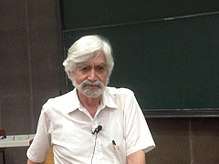George Zweig
George Zweig (/zwaɪɡ/; born May 30, 1937) is a Russian-American physicist. He was trained as a particle physicist under Richard Feynman.[1] He introduced, independently of Murray Gell-Mann, the quark model (although he named it "aces"). He later turned his attention to neurobiology. He has worked as a Research Scientist at Los Alamos National Laboratory and MIT, and in the financial services industry.
George Zweig | |
|---|---|
 George Zweig giving a speech at Department of Physics, National Taiwan University | |
| Born | May 20, 1937 Moscow, Russian SFSR |
| Citizenship | American |
| Alma mater | University of Michigan, California Institute of Technology |
| Known for | Quark model |
| Awards | Sakurai Prize (2015), MacArthur Fellowship 1981, NAS 1996 |
| Scientific career | |
| Fields | physics; neurobiology |
| Institutions | LANL, MIT |
| Doctoral advisor | Richard Feynman |
Early life
Zweig was born in Moscow, Russia, into a Jewish family.[2] His father was a structural engineer. He graduated from the University of Michigan in 1959, with a bachelor's degree in mathematics, having taken numerous physics courses as electives. He earned a PhD degree in theoretical physics at the California Institute of Technology in 1964.
Career
Zweig proposed the existence of quarks at CERN, independently of Murray Gell-Mann, shortly after defending his PhD dissertation. Zweig dubbed them "aces", after the four playing cards, because he speculated there were four of them (on the basis of the four extant leptons known at the time).[3][4] The introduction of quarks provided a cornerstone for particle physics.
Like Gell-Mann, he realized that several important properties of particles such as baryons (e.g., protons and neutrons) could be explained by treating them as triplets of other constituent particles, with fractional baryon number and electric charge. Unlike Gell-Mann, Zweig was partly led to his picture of the quark model by the peculiarly attenuated decays of the φ meson to ρ π,[5][6] a feature codified by what is now known as the OZI Rule, the "Z" in which stands for "Zweig". In subsequent technical terminology, ultimately Gell-Mann's quarks were closer to "current quarks", while Zweig's to "constituent quarks".[7]
Gell-Mann received the Nobel Prize for physics in 1969, for his overall contributions and discoveries concerning the classification of elementary particles and their interactions; at that time, quark theory had not become fully accepted,[8] and was not specifically mentioned in the official citation of the prize. In 1977 Richard Feynman nominated both Gell-Mann and Zweig for the Nobel prize,[9] but neither received the award.[10]
Zweig later turned to hearing research and neurobiology, and studied the transduction of sound into nerve impulses in the cochlea of the human ear,[11] and how the brain maps sound onto the spatial dimensions of the cerebral cortex. In 1975, while studying the ear,[12] he discovered a version of the continuous wavelet transform, the cochlear transform.
In 2003, Zweig joined the quantitative hedge fund Renaissance Technologies, founded by the former Cold War code breaker James Simons. He left the firm in 2010. Once his four-year confidentiality agreement with Renaissance Technologies expired, the 78-year-old Zweig returned to Wall Street and co-founded a quantitative hedge fund, called Signition, with two younger partners. They began trading in 2015. Zweig said "life can be very boring" without work.[13]
Awards and honors
- MacArthur Prize Fellowship (1981)
- National Academy of Sciences (1996)
- Sakurai Prize (2015)
References
- "George Zweig". Mathematics Genealogy Project (North Dakota State University). Retrieved 2010-03-18.
- Panos Charitos interviews George Zweig (2013) CERN Interview.
- G. Zweig (1964), "An SU(3) model for strong interaction symmetry and its breaking", In *Lichtenberg, D. B. ( Ed.), Rosen, S. P. ( Ed.): Developments In The Quark Theory Of Hadrons, Vol. 1*, 22-101 and CERN Geneva - TH. 401 (17 Jan. 1964) 24p.
- G. Zweig (1964), "An SU(3) model for strong interaction symmetry and its breaking II", Published in 'Developments in the Quark Theory of Hadrons'. Volume 1. Edited by D. Lichtenberg and S. Rosen. Nonantum, Mass., Hadronic Press, 1980. pp. 22-101 and CERN Geneva - TH. 412 (21 Feb. 1964) 76p.
- G. Zweig (1980), "Origins of the Quark Model", CALT-68-805
- G. Zweig (2013), "Concrete Quarks: The Beginning of the End" (PDF), CERN colloquium
- Concrete quarks: CERN 2013 colloquium, ditto, FNAL 2014
- Missing hadronic resonance states predicted by the quark model were only established in the early 1970s. Appreciation that flavor SU(3) reflects nothing beyond the symmetries of the three lightest quarks had to wait until the late 1970s. Understanding of the reason free quark searches were turning up negative was lacking until 1974.
- G.Zweig (2010), "Memories of Murray and the Quark Model", International Journal of Modern Physics A, 25 (20): 3863–3877, arXiv:1007.0494, Bibcode:2010IJMPA..25.3863Z, doi:10.1142/S0217751X10050494
- J. Gribbin (1995), Schrödinger's Kittens and the Search For Reality, Phoenix, p. ix, 261 p. : ill. ; 29 cm, ISBN 978-1-85799-402-5
- Zweig, G.; Shera, C. A. (1995). "The origin of periodicity in the spectrum of evoked otoacoustic emissions". The Journal of the Acoustical Society of America. 98 (4): 2018. Bibcode:1995ASAJ...98.2018Z. doi:10.1121/1.413320. PMID 7593924. S2CID 18188510.
- Zweig, G. (1976). "Basilar Membrane Motion". Cold Spring Harbor Symposia on Quantitative Biology. 40: 619–33. doi:10.1101/SQB.1976.040.01.058. PMID 820509., Zweig, G.; Lipes, R.; Pierce, J. R. (1976). "The cochlear compromise". The Journal of the Acoustical Society of America. 59 (4): 975–82. Bibcode:1976ASAJ...59..975Z. doi:10.1121/1.380956. PMID 1262596.
- Chung, Juliet (July 23, 2015). "At 78, Scientist Is Starting a Hedge Fund". The Wall Street Journal. Retrieved December 21, 2019.